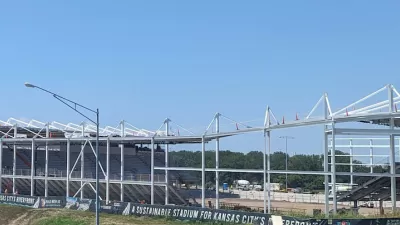In Kansas City, the historic home of jazz and Prohibition-era excess struggles with a redevelopment effort that attempts to build on that era's history while leaving behind some of its essential characteristics, writes Brandon R. Reynolds.
Fifteen years after its commencement, Reynolds discusses the incomplete redevelopment of the Historic 18th & Vine Jazz District into a newly thriving cultural mecca. While the area was once the heart of African-American life and culture in Kansas City, it's now an odd mix of cultural anchors and the simulacra of a bygone era.
Reynolds, in speaking with KC jazz ambassador David Basse, finds that what might be missing from efforts to resuscitate the area as a living, breathing center of culture once again are those elements that formed the foundation of its artistic flourishing: the late-night pleasures of gambling, drinking, and sex.
According to Reynolds, "Basse thinks that Chicago, Memphis, New Orleans, and New York draw people because they not only accept their wayward pasts, they celebrate them, and the things they produced. Kansas City, on the other hand, is more reticent to remind locals and tourists about that whole corruption/prostitution/gambling thing. 'All of that stuff is not something that is easy for a city or a convention and visitors' bureau or a Junior League to put out and say, ‘Come on out and experience this.'"
"Put another way: To not have the excess is to not have jazz. He quotes a musician friend: 'If you're not willing to stay up and party all night, you'll never have jazz in Kansas City, because that's what it's all about.'"
FULL STORY: The Jazz District Authenticity Problem

Planetizen Federal Action Tracker
A weekly monitor of how Trump’s orders and actions are impacting planners and planning in America.

Restaurant Patios Were a Pandemic Win — Why Were They so Hard to Keep?
Social distancing requirements and changes in travel patterns prompted cities to pilot new uses for street and sidewalk space. Then it got complicated.

Map: Where Senate Republicans Want to Sell Your Public Lands
For public land advocates, the Senate Republicans’ proposal to sell millions of acres of public land in the West is “the biggest fight of their careers.”

Maui's Vacation Rental Debate Turns Ugly
Verbal attacks, misinformation campaigns and fistfights plague a high-stakes debate to convert thousands of vacation rentals into long-term housing.

San Francisco Suspends Traffic Calming Amidst Record Deaths
Citing “a challenging fiscal landscape,” the city will cease the program on the heels of 42 traffic deaths, including 24 pedestrians.

California Homeless Arrests, Citations Spike After Ruling
An investigation reveals that anti-homeless actions increased up to 500% after Grants Pass v. Johnson — even in cities claiming no policy change.
Urban Design for Planners 1: Software Tools
This six-course series explores essential urban design concepts using open source software and equips planners with the tools they need to participate fully in the urban design process.
Planning for Universal Design
Learn the tools for implementing Universal Design in planning regulations.
Heyer Gruel & Associates PA
JM Goldson LLC
Custer County Colorado
City of Camden Redevelopment Agency
City of Astoria
Transportation Research & Education Center (TREC) at Portland State University
Camden Redevelopment Agency
City of Claremont
Municipality of Princeton (NJ)





























